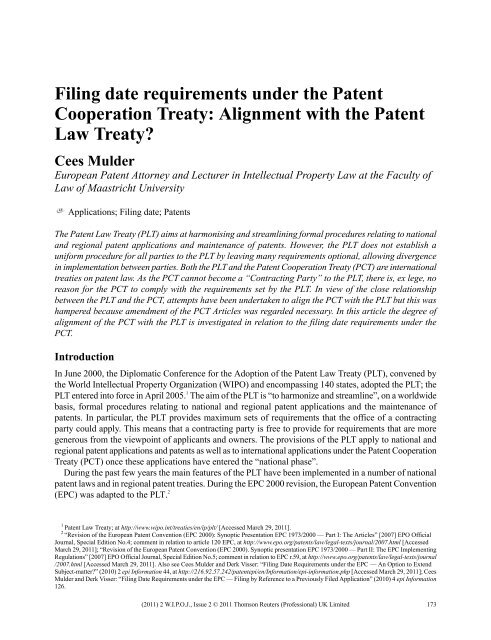WIPO Journal - World Intellectual Property Organization
WIPO Journal - World Intellectual Property Organization
WIPO Journal - World Intellectual Property Organization
Create successful ePaper yourself
Turn your PDF publications into a flip-book with our unique Google optimized e-Paper software.
Filing date requirements under the Patent<br />
Cooperation Treaty: Alignment with the Patent<br />
Law Treaty?<br />
Cees Mulder<br />
European Patent Attorney and Lecturer in <strong>Intellectual</strong> <strong>Property</strong> Law at the Faculty of<br />
Law of Maastricht University<br />
Applications; Filing date; Patents<br />
The Patent Law Treaty (PLT) aims at harmonising and streamlining formal procedures relating to national<br />
and regional patent applications and maintenance of patents. However, the PLT does not establish a<br />
uniform procedure for all parties to the PLT by leaving many requirements optional, allowing divergence<br />
in implementation between parties. Both the PLT and the Patent Cooperation Treaty (PCT) are international<br />
treaties on patent law. As the PCT cannot become a “Contracting Party” to the PLT, there is, ex lege, no<br />
reason for the PCT to comply with the requirements set by the PLT. In view of the close relationship<br />
between the PLT and the PCT, attempts have been undertaken to align the PCT with the PLT but this was<br />
hampered because amendment of the PCT Articles was regarded necessary. In this article the degree of<br />
alignment of the PCT with the PLT is investigated in relation to the filing date requirements under the<br />
PCT.<br />
Introduction<br />
In June 2000, the Diplomatic Conference for the Adoption of the Patent Law Treaty (PLT), convened by<br />
the <strong>World</strong> <strong>Intellectual</strong> <strong>Property</strong> <strong>Organization</strong> (<strong>WIPO</strong>) and encompassing 140 states, adopted the PLT; the<br />
PLT entered into force in April 2005. 1 The aim of the PLT is “to harmonize and streamline”, on a worldwide<br />
basis, formal procedures relating to national and regional patent applications and the maintenance of<br />
patents. In particular, the PLT provides maximum sets of requirements that the office of a contracting<br />
party could apply. This means that a contracting party is free to provide for requirements that are more<br />
generous from the viewpoint of applicants and owners. The provisions of the PLT apply to national and<br />
regional patent applications and patents as well as to international applications under the Patent Cooperation<br />
Treaty (PCT) once these applications have entered the “national phase”.<br />
During the past few years the main features of the PLT have been implemented in a number of national<br />
patent laws and in regional patent treaties. During the EPC 2000 revision, the European Patent Convention<br />
(EPC) was adapted to the PLT. 2<br />
1 Patent Law Treaty; at http://www.wipo.int/treaties/en/ip/plt/ [Accessed March 29, 2011].<br />
2 “Revision of the European Patent Convention (EPC 2000): Synoptic Presentation EPC 1973/2000 — Part I: The Articles” [2007] EPO Official<br />
<strong>Journal</strong>, Special Edition No.4; comment in relation to article 120 EPC, at http://www.epo.org/patents/law/legal-texts/journal/2007.html [Accessed<br />
March 29, 2011]; “Revision of the European Patent Convention (EPC 2000). Synoptic presentation EPC 1973/2000 — Part II: The EPC Implementing<br />
Regulations” [2007] EPO Official <strong>Journal</strong>, Special Edition No.5; comment in relation to EPC r.59, at http://www.epo.org/patents/law/legal-texts/journal<br />
/2007.html [Accessed March 29, 2011]. Also see Cees Mulder and Derk Visser: “Filing Date Requirements under the EPC — An Option to Extend<br />
Subject-matter?” (2010) 2 epi Information 44, at http://216.92.57.242/patentepi/en/Information/epi-information.php [Accessed March 29, 2011]; Cees<br />
Mulder and Derk Visser: “Filing Date Requirements under the EPC — Filing by Reference to a Previously Filed Application” (2010) 4 epi Information<br />
126.<br />
(2011) 2 W.I.P.O.J., Issue 2 © 2011 Thomson Reuters (Professional) UK Limited<br />
173

















